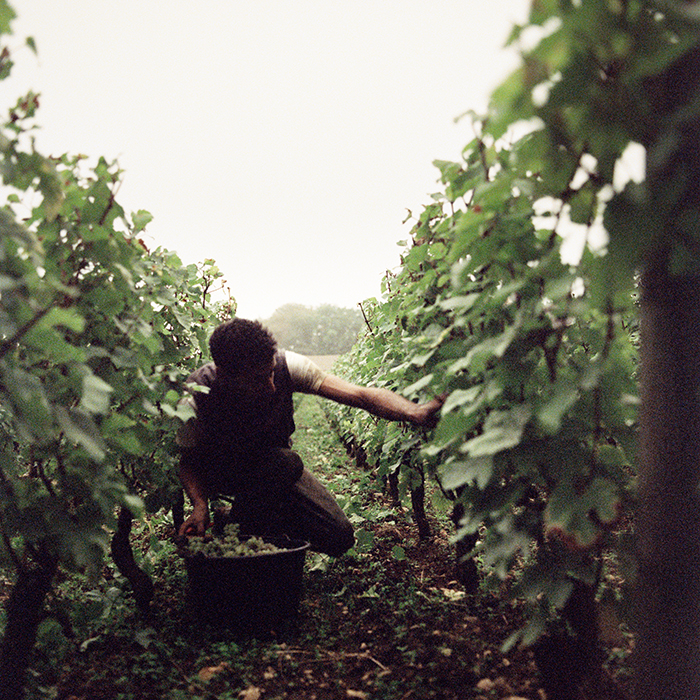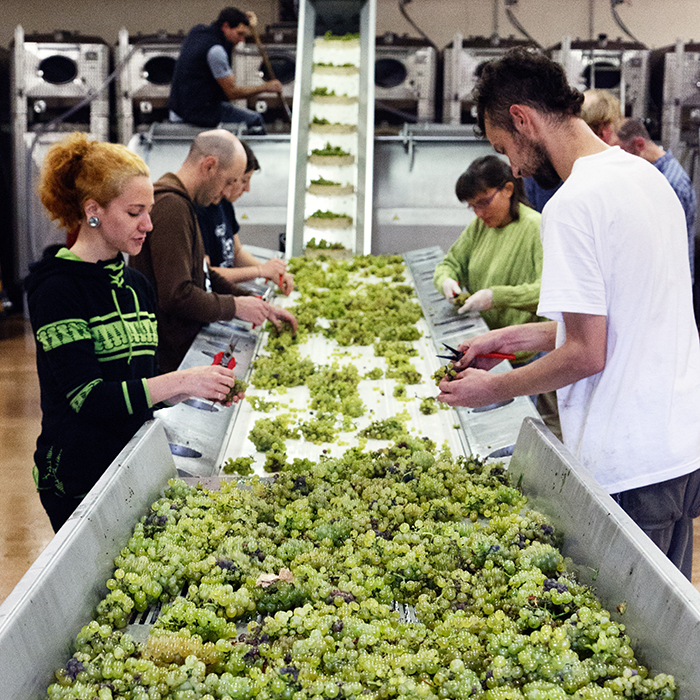How to make wine: white
Author: Barbara Drew MW

A French picker in the vineyard. Photograph: Jason Lowe
By their nature, white wines are more fragile than reds; without the antioxidant properties of tannins to protect them, the juice and wines themselves can quickly become oxidised – brown and dull in appearance, nutty and bitter in flavour. As such, at every stage of the process, oxygen is excluded as much as possible, and the grapes and juice are treated very gently.
Those grapes which are machine harvested are often sent straight into chilled hoppers or sprayed with sulphur dust to preserve them until they reach the winery. Those grapes which are hand harvested are gently picked and put into small boxes, to prevent the weight of lots of grapes crushing them. Either way, on arrival at the winery the grapes are sorted, to remove the inoffensively named MOG (“Matter Other than Grapes”, which can include anything from leaves and twigs to ladybirds and even the occasional lizard).
The next step is crushing, to get the juice from the grapes. This can be done very gently, to secure the cleanest, purest, most delicate juice. This is crucial for light, neutral wines such as Pinot Grigio. Some producers will then take the grape skins and press them again, much more firmly, to release small quantities of thick, dark juice. On its own it may look unappealing but, for pungent wines such as Sauvignon Blanc, this press juice can add much-needed flavour and texture to a wine.
Fermentation is the next step; for white winemaking vintners do not need to worry about the skins, seeds or stems, but there is still plenty for them to consider. What temperature do they want to ferment the juice at, do they need to add cultured yeast, and what type of vessel might they ferment the juice in?
Given enough time, most vats of grape juice (high in sugar and nutrients) will start fermenting on their own; there are sufficient yeasts in the air and in a winery to make this a reality. However, many winemakers choose to control this part of the process by adding specific yeasts. These ensure the fermentation progresses without problems and, further, can add specific characteristics to a wine. For example, the catchily named CY3079 is often used to give Chardonnays a creamier, more buttery flavour, while QA23 can increase the pungent passion fruit aromas of a Sauvignon Blanc.
The temperature of fermentation is also key; cooler ferments (around 12 degrees) can lead to very fruity wines while warmer ferments (20 degrees) can often lead to more smoky notes developing in the wine. At very high temperatures (over 33 degrees) the yeasts can even die, so it is important to control the temperature of the fermentation, either by using small barrels, so heat can dissipate quickly, or using high-tech stainless steel tanks with in-built thermostats.

Grape sorting in the winery, Burgundy. Photograph: Jason Lowe
The array of vessels in which wine can be fermented is increasingly broad. From traditional large oak barrels, used for so many decades that they have ceased to add flavour to the wine, to small, new barrels that give a toasty flavour, oak has been the traditional material of choice. Many producers, however, prefer large stainless steel tanks which are much easier to clean and keep cool. For others, concrete fulfils their needs, maintaining a constant temperature during fermentation. Whichever vessel is chosen, cleanliness is key and they must all be cleansed thoroughly after fermentation.
Once the yeasts have converted all the sugar into alcohol, the wine is left to settle for a few days, before being racked: this is when the wine is drained off, and the lees – dead yeast cells that have sunk to the bottom of the tank – are removed.
A few wines may remain on their lees for much longer. In some Chardonnay wines, for example, the dead yeast cells can continue to add flavour to the wine, adding a brioche character and sometimes a creamier, richer texture. Some winemakers even stir the lees every few weeks to enhance this flavour effect. Other wines may go into oak barrels to slowly develop additional flavours. For example, traditionally white Rioja will age in French and American oak barrels, adding honey, nut and hay characters to the wine, before being bottled years later.
Once ready for bottling, most wines will receive a gentle filtration (to remove any small stray particles, large proteins or even yeasts and bacteria), and a dose of sulphur dioxide to help preserve the freshness of the wine while it is in bottle. Sulphur has been used as a preservative for wine for well over 2,000 years, but its use remains somewhat controversial. While it can help to protect a wine from oxidation, and prevent any unwanted microbial activity in bottle, some winemakers argue that it is not necessary. Certainly for rich and robust white wines, with high acidity and no residual sugar, minimal sulphur should be needed to preserve them. For fruitier wines with some sugar that risk refermenting in bottle, more care is required, and, in the absence of sulphur, a careful filtration to remove all yeasts may be needed. Whichever path is chosen, the wines should be kept dark and cool until that glorious moment when the cork is popped, or the screwcap twisted off, and the wonderful liquid poured into a waiting glass.
This article was originally sent to members of our Wine Club. You can find out more about the benefits of Wine Club here; if you join before 26th October, you’ll receive a £50 gift voucher.



[…] This article was originally sent to members of our Wine Club. You can find out more about the benefits of Wine Club here. You’ll find the first part of this series, looking at white wine, here. […]